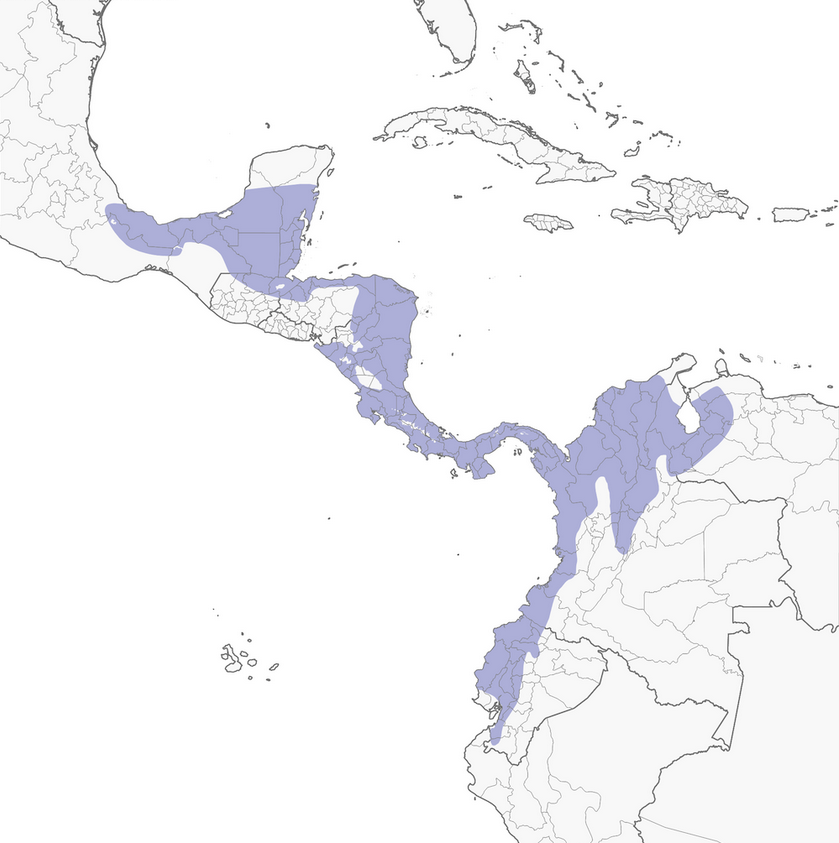Rufous-tailed Hummingbird
Regional Species
The Rufous-tailed Hummingbird is perhaps the most common species of hummingbird at the forest edge and in gardens and cultivated areas from southern Mexico to northwestern South America. It has a distinctly rufous-colored tail, from which its named is derived, and a bright pink bill with a black tip. Like other hummingbirds, it feeds on nectar and small insects, and it can be highly territorial over feeding areas.
Range

Habitat
![]() The Rufous-tailed Hummingbird is common in "non-forest" areas including clearings, gardens, forest edges and some secondary forests. It prefers lower habitats and may be seen at bird feeders made by humans that are in open areas with some coverage.
The Rufous-tailed Hummingbird is common in "non-forest" areas including clearings, gardens, forest edges and some secondary forests. It prefers lower habitats and may be seen at bird feeders made by humans that are in open areas with some coverage.
Food
![]() The Rufous-tailed Hummingbird feeds on nectar of Heliconia, banana and coffee flowers, among others. Like most hummingbirds, they supplement their low-protein diet with small insects. They also visit human-made feeders with a mixture of water and sugar.
The Rufous-tailed Hummingbird feeds on nectar of Heliconia, banana and coffee flowers, among others. Like most hummingbirds, they supplement their low-protein diet with small insects. They also visit human-made feeders with a mixture of water and sugar.
Behavior
![]() The Rufous-tailed Hummingbird is extremely aggressive and territorial. It dives at other hummingbirds or large insects (such as butterflies) that invade their feeding area. Like many other hummingbirds, its metabolic rate is so high that it goes into a torpor state at night to conserve energy. The Rufous-tailed Hummingbird is polygynous. Males will often become territorial over an area of flowers, presumably not only for their nectar but for courting females.
The Rufous-tailed Hummingbird is extremely aggressive and territorial. It dives at other hummingbirds or large insects (such as butterflies) that invade their feeding area. Like many other hummingbirds, its metabolic rate is so high that it goes into a torpor state at night to conserve energy. The Rufous-tailed Hummingbird is polygynous. Males will often become territorial over an area of flowers, presumably not only for their nectar but for courting females.
Nesting
![]() Females choose small trees or shrubs as nesting sites. The nest is made of plant fibers, leaves and spiderwebs, and is covered with moss and lichen. If the nest is destroyed, the Rufous-tailed Hummingbird will rebuild another. The female usually lays 2 eggs and does all the incubation and parental care. Even though females are also aggressive they sometimes nest colonially.
Females choose small trees or shrubs as nesting sites. The nest is made of plant fibers, leaves and spiderwebs, and is covered with moss and lichen. If the nest is destroyed, the Rufous-tailed Hummingbird will rebuild another. The female usually lays 2 eggs and does all the incubation and parental care. Even though females are also aggressive they sometimes nest colonially.
Appearance
Size & Shape
The Rufous-tailed Hummingbird is a medium-sized hummingbird of approximately 10 cm long.
Color Pattern
The Rufous-tailed Hummingbird has a distinctly rufous-colored tail, from which its name is derived, and a bright pink bill with a black tip. Its body is generally green. The green of the male tends to be much brighter in his throat and chest than the green in the female.
Similar Species
The Rufous-tailed Hummingbird is similar in appearance to several other species of hummingbirds with green bodies and rufous tails. However, other Amazilia hummingbirds have other characteristics that are lacking in the Rufous-tailed Hummingbird. For example, the Snowy-bellied Hummingbird has a distinct white belly, and the green is more uniform over its body.
Did you know?!
The Rufous-tailed Hummingbird will often cohabit a man-made feeder with other hummingbirds, though Rufous-tailed Hummingbirds often spend more time chasing off other birds and insects than feeding.
While aggressive, it will sometimes nest colonially.
